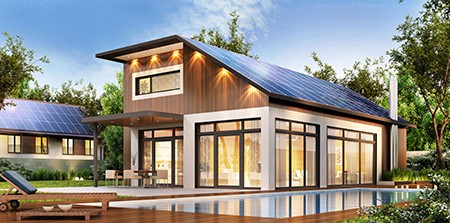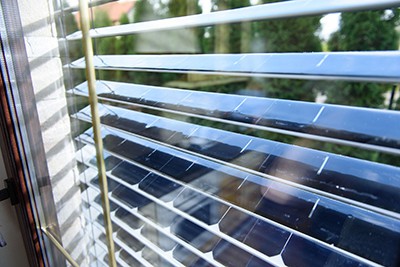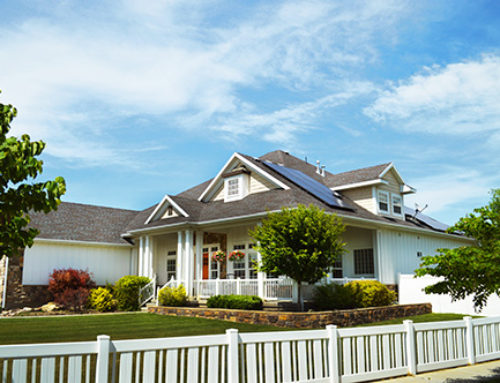Windows Double a Solar Panels?
Windows aren’t just for looks. Now they can lower your energy bills, too!

You may be familiar with conventional roof-mounted and ground-mounted solar photovoltaic (PV) systems that use silicon panels to offset electricity. Solar hot water heaters are fairly common as well.
The solar power industry has found a way for solar to energize homes through windows, too. A solar panel window comes with transparent solar cells to process sunlight, just like traditional solar panels. But unlike a regular solar panel, transparent solar windows are packed with transparent photovoltaic glass that lets visible light through and converts it into renewable electricity.
With these forms of solar energy, homeowners and companies can save tremendous amounts of money and reduce their carbon footprint.
- A History of Solar Windows
- Why Were Solar Windows Created?
- How Solar Windows Work?
- How Much Energy do Solar Windows Produce?
- Where to Find Solar Windows?
- Environmental and Practical Benefits
- The Future of Solar Windows

A History of Solar Windows
Solar-powered windows were created by a company called Physee. With a diverse and innovative team of chemists, engineers, researchers, and business-savvy individuals, Physee found a way to put a solar panel on existing window glass to produce energy and improve energy efficiency.
Not only do they provide a convenient way for homes and buildings to create solar energy, but they fit almost any window surface and don’t stand out like traditional solar arrays.

Why Were Solar Windows Created?
Solar windows were created for several reasons. One is aesthetics. While everyone enjoys having the energy savings and environmental benefits that traditional solar PV systems produce, not everyone likes the sight of a large solar energy system on a roof or a property.
This can be a problem for businesses looking to attract customers and clients. It can also spark conflict between homeowners and their neighbors.

But discreet window-based solar glass, which channels sunlight into solar energy near the window frame, offsets fossil fuel-based energy consumption without altering the appearance of a building or landscape. Once you install transparent photovoltaics, it looks just like a glass window.
The second advantage of solar windows is their energy outputs. Solar-powered windows provide clean electricity produced by conventional PV systems. Generally speaking, traditional solar systems work best on south-facing buildings. This is great for buildings with plenty of daytime sun exposure.
For those without ideal light exposure, however, it is much more difficult to generate solar energy. The advantage of using a glazed window to absorb solar energy is that it can capture sunlight throughout the day using solar cells. This solar cell system is much better than using solar technology limited to channeling light from a certain direction or angle.
Window-based solar technology is a revolutionary breakthrough for homeowners and building owners who want to maximize efficiency and wouldn’t otherwise get enough energy from a solar PV system. It’s also a big step forward for the solar power industry, which is always looking for new and improved ways to deliver clean energy to customers.

How Solar Windows Work
Solar windows convert sunlight that passes through their tiny solar cells. These cells are placed at precise angles to collect light that comes through the window near the window frame.
The panels, called “solar concentrators,” funnel light to capture the ideal sunlight on the solar spectrum coming through the glass. The solar concentrators convert the captured energy (measured in kilowatts). Excess energy that the panels generate simply passes through to the battery. The amount of sunlight that windows convert into energy depends on several variables, including where the windows are located, the time of year, and the local climate.
Solar windows are also beneficial for larger buildings that don’t have the roof capacity necessary to hold large solar PV systems that would offset their energy usage. Since the windows can capture sunlight throughout the day and convert it to energy, they can be the last missing piece that large buildings need to be totally independent of traditional energy. Therefore, many buildings remain connected to the grid to get traditional backup energy if necessary.

How Much Energy do Solar Windows Produce?
The numbers alone might not mean much to you, but they make more sense put into a practical perspective. Each solar window can produce anywhere between eight and 10 watts daily, depending on the volume of solar lights absorbed through its cells. This power generation is enough to fully charge one cell phone per meter twice a day.
This means that everyone in the office can power their phones! Any excess energy that the windows produce that you don’t need to use in a day is sent into a battery, where it remains stored until you need to use it.
If you have a large solar battery charger, you can use it to collect solar windows’ energy. Keep in mind that most solar batteries are intended for smaller devices, although some are great for large-scale solar use.

Where to Find Solar Windows
To date, notable solar window projects include installing solar windows at the headquarters of Rabobank in the Netherlands, where more than 300 square feet of windows have been outfitted with thin silicon panels that absorb solar energy and convert it to energy.
- Corporate headquarters
- Commercial buildings
- Apartment complexes
Other commercial business buildings and apartment complexes in the Netherlands have also had solar windows installed. This clean energy technology is also gaining traction with the rest of the world, including the US. What sets solar windows apart from other types of solar is the fact that they are easy to install and require little or no modification of an existing structure.
This is an especially significant advantage for buildings with older roofs that might otherwise need to get a roof replacement or have roof work done before installing solar. Both options can be expensive!

Environmental and Practical Benefits
Solar windows operating at peak capacity can offset a building’s energy usage by up to 20 percent daily. Over time, this offsets significant light, heat, air conditioning, and even pollution produced from commuting. This gives businesses with solar windows bragging rights to share with clients and customers:
- Less pollution
- Reduced carbon footprint
- Lower utility bills

The Future of Solar Windows
With so many opportunities and solutions available, the solar energy industry is always looking to create new solar energy methods. A considerable amount of time is also spent improving upon existing technology. Therefore, it might not be surprising that many companies have already taken steps to produce their own more attractive and more energy-efficient versions of the first solar windows. Solar lights and solar blinds are also being developed.
At the National Renewable Energy Laboratory (NREL), scientists have already created a more powerful energy-collecting system for windows. This system makes commercial buildings and homes more energy-efficient without detracting from their aesthetic appeal.
The same solar collecting technology, which comes in a thin panel, is placed in an existing window. The panels start to work as soon as they are exposed to light. Although the technology used in them is microscopic, these solar windows significantly minimize traditional energy usage.
This is because they change color as needed to maximize energy absorption across the solar spectrum throughout the day. While the power output of solar windows is impressive, research is ongoing to extend their lifespan. Along with the NREL, private companies and educational facilities are also making solar windows more efficient and affordable.
With their discreet appearance, ability to lower utility bills, and ease of integrating with existing structures, solar windows are rapidly becoming a popular renewable energy source. Solar panels on a glazed window are thin and hard to detect on the surface of the window’s glass, which means that they don’t create an eyesore. Solar cells in the panels are hard at work converting sunlight into energy.
